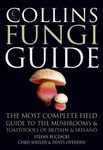![The Agaric Genera Marasmius, Chaetocalathus, Crinipellis, Heimiomyces Resupinatus, Xerula and Xerulina in Malesia The Agaric Genera Marasmius, Chaetocalathus, Crinipellis, Heimiomyces Resupinatus, Xerula and Xerulina in Malesia]()
Click to have a closer look
About this book
Customer reviews
Related titles
About this book
Many species of these small agarics occur in Malesian forest. They help decompose the enormous variety of the litter, such as fallen leaf-blades, petioles, twigs. branches, trunks, inflorescences, fruits and roots. Some act specifically for they are always found on the same plant remains; others are more generalised, but none seems able to decompose one kind of plant material in its entirety. Indeed, the greater the diversity of this litter in both structural and systematic origin, so the saprophytic flora multiplies. Malesian forest has, perhaps, the richest systematic diversity in the world, whether dicotyledonous, monocotyledonous or cryptogamic. An element which by no means predominates is the Fagaceous with five large genera and some 180 species in Malesia, that is from the Malay Peninsula to New Britain. It pales before the numbers of Annonaceae, Dipterocarpaceae, Euphorbiaceae. and Palmae, about which very little is known of the specific decomposition of their litter. The phanerogamic flora is widely different both specifically and generically from that of Africa or America and, accordingly, very few of the species of Marasmius and its allies appear to be pantropical.
About 100 species of these agarics are here described. They are the ones for which the author has sufficient microscopic detail, but he has c. 250 collections with field-notes from Malesia, including c. 90 from Malaya, 73 from Borneo and c. 60 from the Solomons. There may well be three or four hundred species in all. Thus, this account is an introduction where world literature on Marasmius is hard to come by.
The author has taken Marasmius in its original and wide sense because. as explained in the following pages, there seems to be no sharp distinction between Marasmius s. str. of modern taxonomy, Marasmiellus and a large part of Collybia. Thus, Marasmius becomes the receptacle for white-spored agarics with rather tough and skinny fruit-bodies, but the criterion is the presence of fusoid or subacerose basidioles in the hymenium. The fruit-bodies have not the waxy-tough consistency of Trogia and, with the exception of Heimiomyces, are not sarcodimitic; Trogia, moreover, lacks these basidioles. However, the old idea that the fruit-bodies of Marasmius can revive after drying or that they are marcescent (meaning drying up without straightway decaying) is not true for many tropical species or, indeed, for many temperate ones.
Customer Reviews






































![Bibliotheca Diatomologica, Volume 38: Insel der Endemiten: Geobotanisches Phänomen Neukaledonien [Island of Endemics: New Caledonia – A Geobotanical Phenomenon]](http://mediacdn.nhbs.com/jackets/jackets_resizer_medium/94/94205.jpg?height=150&width=96)
![Bibliotheca Diatomologica, Volume 15: Bacillariaceae, Epithemiaceae, Surirellaceae [German]](http://mediacdn.nhbs.com/jackets/jackets_resizer_medium/62/62828.jpg?height=150&width=93)





